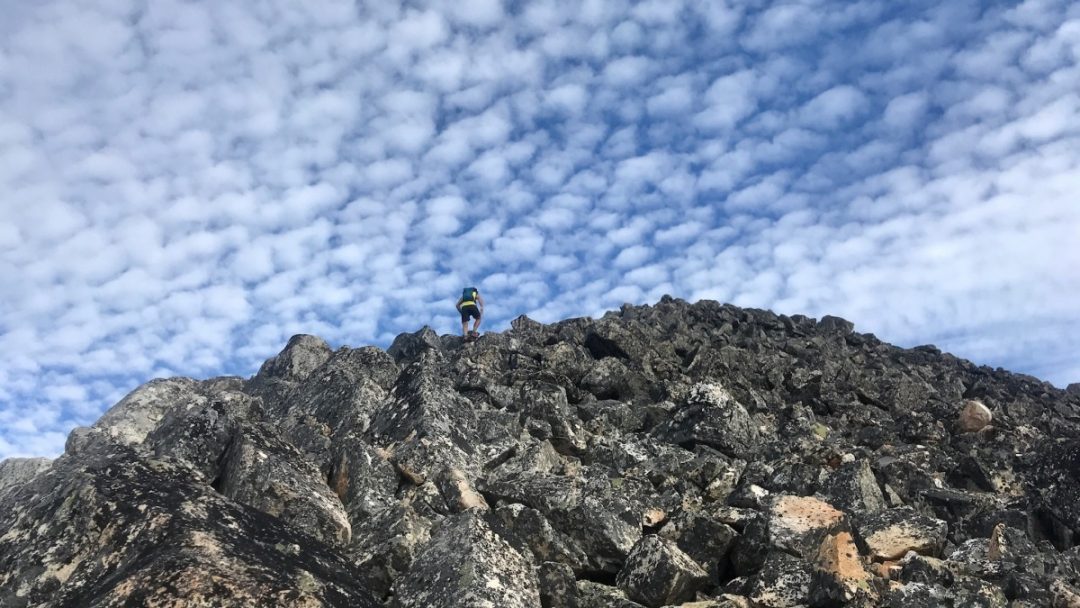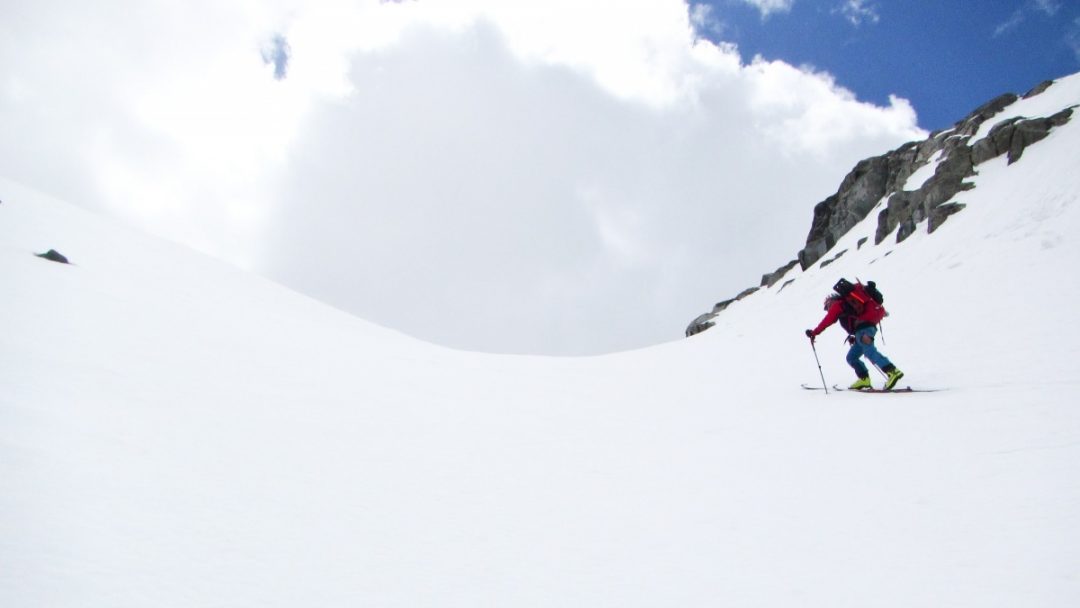
Fall is transition seasons, which also mean you’ll be transitioning from running & biking to skiing. Photo: Sam Naney
This is part one of a three-part series on ski specific fitness as we transition into the winter season.
Part 1: Transitioning From General to Specific Activities
Are you an avid tourer/ski mountaineer, or are you inspired to put on a race bib and toe the line at an ever-more-popular skimo race? Maybe you’re a fitness lapper in the pre-lift hours of your local area? Despite the myriad ways to experience skiing mountains, there are commonalities to training for each discipline. And it is exactly this training that will prepare you to enjoy the season with confidence, avoid injuries, and make your ski partners dig just a bit deeper to keep pace as the day stretches on.
The focus here isn’t necessarily to crush Strava segments or set glorious FKTs; enjoyment (as well as safety) in the mountains gets a big contribution from a good aerobic base and strength. Building yourself a good buffer of fitness allows you to better relax and take in the sights, instead of feeling like you’re sucking through a milkshake straw and dragging leaden legs up the skinner. Good fitness = happier skiers.
Our forthcoming three-part series will help you prepare for the upcoming season. Today’s article focuses on the broader ideas around successfully transitioning your training from the summer / fall months of hiking, running, biking, etc., into more ski-specific workloads. The focus here isn’t necessarily to crush Strava segments or set glorious FKTs; enjoyment (as well as safety) in the mountains gets a big contribution from a good aerobic base and strength. Building yourself a good buffer of fitness allows you to better relax and take in the sights, instead of feeling like you’re sucking through a milkshake straw and dragging leaden legs up the skinner. Good fitness = happier skiers.
Moving from General to Specific Activities
Whether you’ve been logging miles running, backpacking, or spinning a high cadence on pavement or narrow singletrack, Fall is transition season for skiers. When moving from dryland to snow, the first thing to consider is how specifically your body has been moving vis-à-vis skinning on skis or a splitboard. Running and hiking, being foot-borne, more closely mimic the demands of skinning uphill than biking or rowing, both non-weight-bearing and done in a seated position. However, no dryland training will perfectly prepare you for skiing. It’s essential to consider these differences and how you can start to move closer to simulating the touring motion.
Running is a great all-around tool for building fitness and maintaining functional strength. If you have maintained a running base through the summer, it will continue to provide an excellent method to firm up impact resistance in your lower limbs. When you look to start modifying your running training to benefit skiing, add more vertical gain in your workouts. Don’t be afraid to switch to power-hiking with a quick cadence to mimic the turnover and stride in a skin track. If you’re aiming to do some skimo racing, it’s also good to include even faster cadence work and moose-hoofing sessions.
This video is part one of a three part video series from Cascade Endurance on dryland skills for skiing.
You don’t need to (nor should you) move directly into running miles if they haven’t been a part of your diet; you can instead find a local hill and begin chewing up some vert by hiking uphill. No hill? Try a treadmill at 15+ percent grade. No treadmill? Even brisk hiking on mellow/flat terrain with a small pack introduces a sufficient load to your body. In more vertically oriented training sessions, bring trekking poles (or just your winter ski poles) to add the arms and regain that synergy of arm and leg cadence in concert. Believe it or not, if you’ve been running or biking all summer without much upper-body work, the first few days using poles in a steep skin track can generate some soreness. Be conservative with the downhills, too; a huge fitness base from cycling all summer won’t save you from thrashed quads on a hiking or running descent if you let the speed get away from you. Better to keep it chill and be able to do it again the next day.
In a future installment, we’ll dive more into some specifics on how you can structure your aerobic and intensity training toward ski touring, including utilizing the dreaded (or beloved?) heart rate monitor to ensure you’re not goosing the throttle on every outing.
In addition to the general increase of uphill, foot-borne exercise, it’s time to also think about how to improve your skiing technique. If you watch successful skimo racers, they often utilize a higher turnover in the skin track, especially in steep terrain, staying on top of their skis and maximizing the grip of their skins without blowing out the kick behind them. Again, we’re not all looking to be lycra-clad crushmasters. But watching how these top men and women move in a skintrack can help inform how we might adapt those techniques to longer and lower-intensity touring days, to maximize economy and minimize energy demand.

Early season fitness means feeling better in the hills no matter the objective: slow-slog traverse in the Wind Rivers or race speedy in March for the Grand Traverse. Photo: Brian Parker.
If you have spent the summer months on a bike, now is definitely the time to start weighting your feet again with some of the techniques described above. Your leg muscles need to experience the impact of the ground to build strength not only for touring uphill but to sustain the repeated squat impacts of many thousands of feet of descent. In the next part of this series, we’ll discuss how you can supplement this time on your feet with some resistance training in a gym setting, allowing a more localized attack on those skiing muscles to get them toned and ready for the slopes.
Finally, after a few weeks of transition activity, consider adding a small pack to mimic your standard day-tour pack, perhaps 10–15 pounds total. Again, think specificity. You don’t want your first day with a pack or poles to be your first tour of the year; get your body prepped in advance, so it feels natural and familiar when you step into (or set) the first skinner of the season.
Sam Naney grew up in the North Cascades of Washington State, and dedicated much of his young life to Nordic ski racing. He attended Dartmouth College where he earned a degree in History, skiing four years on the varsity squad before graduating and commencing a post-collegiate career, racing domestically and internationally until 2014 when he retired from racing to begin his coaching journey. After five years working with his own former coach Scott Johnston at Uphill Athlete, where he was most recently the Director of Coaching, Sam now serves as Program Director for the Methow Valley Nordic Ski Team, and also co-owns and operates Cascade Endurance with his wife Alison, offering endurance training resources and events across the Pacific Northwest and beyond. When he’s not chasing new lines in the mountains by foot or by ski, nor chasing little kids around at ski practices, he chases his own two daughters Fiona and Isabella, his wife and their Siberian Husky across his home range.
Sam Naney grew up in the North Cascades of Washington State, and dedicated much of his young life to Nordic ski racing. He attended Dartmouth College where he earned a degree in History, skiing four years on the varsity squad before graduating and commencing a post-collegiate career, racing domestically and internationally until 2014 when he retired from racing to begin his coaching journey.
After five years working with his own former coach Scott Johnston at Uphill Athlete, where he was most recently the Director of Coaching, Sam now serves as Program Director for the Methow Valley Nordic Ski Team, and also co-owns and operates Cascade Endurance with his wife Alison, offering endurance training resources and events across the Pacific Northwest and beyond. They include The Fifty aspirant, Cody Townsend, as a client. When he’s not chasing new lines in the mountains by foot or by ski, nor chasing little kids around at ski practices, he chases his own two daughters Fiona and Isabella, his wife and their Siberian Husky across his home range.

